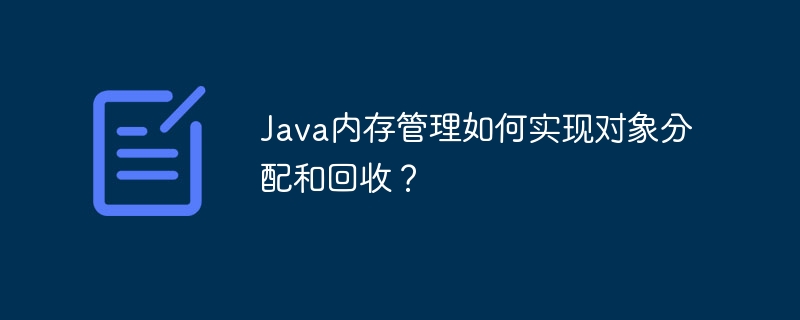
Java memory management uses garbage collection (GC) technology to dynamically allocate and reclaim objects to ensure that applications run efficiently. Objects are allocated in the heap, and when they are no longer referenced, they are reclaimed through mark-and-sweep algorithm and generational garbage collection to release the memory occupied.

Java Memory Management: Implementation of Object Allocation and Recycling
The memory management system of the Java Virtual Machine (JVM) is responsible for dynamic allocation and recycling objects, ensuring efficient and reliable application execution. It uses a technique called garbage collection (GC), which automatically releases the memory occupied by an object when it is no longer referenced.
Object Allocation
When a new object is created, the JVM allocates a memory in the heap to store its data. The heap is a large memory pool managed by the JVM that stores instances of all objects. The allocation process is as follows:
Object obj = new Object(); // 创建一个对象并将其分配到堆中
Object recycling
When the object is no longer referenced, the JVM will use the garbage collector to reclaim the memory it occupies. The garbage collector is a background thread that runs periodically while the application is running. It uses the following techniques to identify unwanted objects:
Practical case
Consider the following code snippet:
Object obj1 = new Object(); // 创建对象 obj1 Object obj2 = obj1; // obj2 指向 obj1 的相同位置 obj1 = null; // 现在只保留对象 obj2 的引用
In this case, the obj1 object is no longer referenced and should be GC recycling. However, obj2 still points to the same memory location, so obj1 will not be recycled.
Conclusion
Java memory management ensures the smooth running of applications through efficient object allocation and recycling mechanisms. The garbage collector helps eliminate memory leaks and frees up memory resources that are no longer needed, thereby improving application performance and stability.
The above is the detailed content of How does Java memory management implement object allocation and recycling?. For more information, please follow other related articles on the PHP Chinese website!
 WeChat failed to load data
WeChat failed to load data What are the employment directions in Java?
What are the employment directions in Java? getelementbyid
getelementbyid Data encryption storage measures
Data encryption storage measures unicode to Chinese
unicode to Chinese Zero-based Java self-study tutorial
Zero-based Java self-study tutorial Is the success rate of railway 12306 standby ticket high?
Is the success rate of railway 12306 standby ticket high? How to implement h5 to slide up and load the next page on the web side
How to implement h5 to slide up and load the next page on the web side



